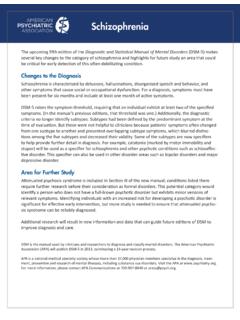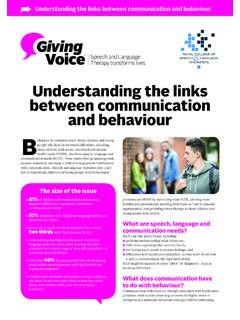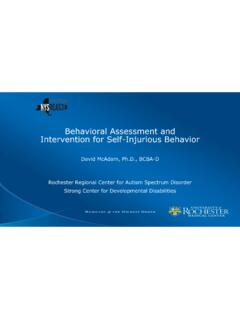Transcription of Algorithm for the Assessment and Management of hildhood ...
1 Algorithm for the Assessment and Management of Childhood Obesity in Patients 2 Years and Older This Algorithm is based on the 2007 Expert Committee Recommendations,1 new evidence and promising practices. Healthy Weight (BMI 5-84%) Obesity (BMI > 95%) Family History Review of Systems Physical Exam Routine Care Provide ongoing positive reinforcement for healthy behaviors. For patients in the healthy weight category, screen for genetic dyslipidemia by obtaining a non-fasting lipid profile for all children between the ages of 9-11 and again between For patients in the overweight category, obtain a lipid profile. Maintain weight velocity: Crossing 2 percentile lines is a risk for obesity4 Reassess annually Follow up at every well-child visit.
2 Overweight (BMI 85-94%) Augmented (obesity-specific)1 Family History Review of Systems Physical Exam Lab Screening The 2007 Expert Committee Recommendations1 state that a fasting glucose and fasting lipid profile along with ALT and AST should be obtained. Additionally, guidelines from the ADA and Endocrine Society recommend using A1C, fasting glucose or oral glucose tolerance to test for diabetes or pre-diabetes. The ADA notes that there are presently limited data supporting A1C for diagnosing diabetes in children and adolescents; however, they are continuing to recommend A1C at this For patient convenience, some providers are obtaining non-fasting labs.
3 Clinical judgment, local preferences and availability of testing should be used to help determine the timing of follow up of abnormal labs. Of note, some subspecialty clinics are screening for Vitamin D deficiency and insulin resistance by obtaining labs for Vitamin D and fasting insulin. The clinical utility and cost effectiveness of such testing is yet to be determined. Currently, there are no guidelines on when to start laboratory testing for patients with obesity. Based upon the patient s health risk, some experts may start screening patients at 2 years of age. Augmented (obesity-specific)1 Family History Review of Systems Physical Exam Obesity-related conditions: The following conditions are associated with obesity and should be considered for further work-up.
4 Additional lab tests may be warranted if indicted by the patient s clinical In 2014, consensus statements from The Children s Hospital Association described the Management of a number of these ,7 Endocrine: Polycystic ovarian syndrome (PCOS) Precocious puberty Prediabetes: Impaired fasting glucose and/or impaired glucose tolerance as demonstrated during a GTT Premature adrenarche Type 2 Diabetes Dermatologic: Acanthosis nigricans Hirsutism Intertrigo Gastrointestinal: Cholelithiasis Constipation GERD Nonalcoholic fatty liver disease or steatohepatitis Neurologic: Pseudotumor cerebri Move on to next page 2015 AAP Institute for Healthy Childhood Weight Assess Behaviors Assess healthy eating and active living behaviors Determine Weight Classification Accurately determine weight and height, calculate and plot Body Mass Index (BMI) and determine BMI percentile.
5 Provide Prevention Counseling 5 (fruits & vegetables) 2 (hours or less of screen time) 1 (hour or more of physical activity) 0 (sugary drinks) every day! Risk Factors Present Risk Factors Absent Determine Health Risk Factors* Orthopedic: Blount s Disease Slipped capital femoral epiphysis (SCFE) Psychological/Behavioral Health: Anxiety Binge eating disorder Depression Teasing/bullying *Based on behaviors, family history, review of systems, and physical exam, in addition to weight classification. 8/2016 Management and Treatment Stages for Patients with Overweight or Obesity Patients should start at the least intensive stage and advance through the stages based upon the response to treatment, age, BMI, health risks and motivation.
6 An empathetic and empowering counseling style, such as motivational interviewing, should be employed to support patient and family behavior ,9 Children age 2 5 who have obesity should not lose more than 1 pound/month; older children and adolescents with obesity should not lose more than an average of 2 pounds/week. Where/By Whom: Pediatric Weight Management Clinic/Multi-disciplinary Team What: Increased intensity of behavior changes, frequency of visits, and specialists involved. Structured behavioral modification program, including food and activity monitoring, and development of short-term diet and physical activity goals. Goals: Positive behavior change.
7 Weight maintenance or a decrease in BMI velocity. Follow-up: Weekly or at least every 2 4 weeks as determined by the patient, family, and physician. After 3 6 months, if the BMI/weight status has not improved consider advancing to Stage 4. Where/By Whom: Primary Care Office/Primary Care Provider with appropriate training What: Same intervention as Stage 1 while including more intense support and structure to achieve healthy behavior change. Goals: Positive behavior change. Weight maintenance or a decrease in BMI velocity. Follow-up: Every 2 - 4 weeks as determined by the patient, family and physician. After 3 6 months, if the BMI/weight status has not improved consider advancing to Stage 3.
8 References 1. Barlow S, Expert Committee. Expert committee recommendations regarding prevention, Assessment , and treatment of child and adolescent overweight and obesity: Summary report. Pediatrics. 2007;120(4):S164-S192. 2. US Department of Health and Human Services. Expert panel on integrated guidelines for cardiovascular health and risk reduction in children and adolescents: Full report. 2012. 3. American Diabetes Association. Classification and diagnosis of diabetes. In Standards of Medical Care in Diabetes 2015. Diabetes Care 2015;38( ):S8-S16. 4. Taveras EM, Rifas-Shiman SL, Sherry B, et al. Crossing growth percentiles in infancy and risk of obesity in childhood.
9 Arch Pediatr Adolesc Med. 2011;165(11):993-998. 5. Copeland K, Silverstein J, Moore K, et al. Management of newly diagnosed type 2 Diabetes Mellitus (T2DM) in children and adolescents. Pediatrics. 2013;131(2):364-382. 6. Estrada E, Eneli I, Hampl S, et al. Children's Hospital Association consensus statements for comorbidities of childhood obesity. Child Obes. 2014;10(4):304-317. 7. Haemer MA, Grow HM, Fernandez C, et al. Addressing prediabetes in childhood obesity treatment programs: Support from research and current practice. Child Obes. 2014;10(4):292-303. 8. Preventing weight bias: Helping without harming in clinical practice. Rudd Center for Food Policy and Obesity website.
10 9. Resnicow K, McMaster F, Bocian A, et al. Motivational interviewing and dietary counseling for obesity in primary care: An RCT. Pediatrics. 2015;134(4): 649-657. Where/By Whom: Pediatric Weight Management Center/Providers with expertise in treating childhood obesity What: Recommended for children with BMI > 95% and significant comorbidities if unsuccessful with Stages 1 - 3. Also recommended for children > 99% who have shown no improvement under Stage 3. Intensive diet and activity counseling with consideration of the use of medications and surgery. Goals: Positive behavior change. Decrease in BMI. Follow-up: Determine based upon patient's motivation and medical status.








